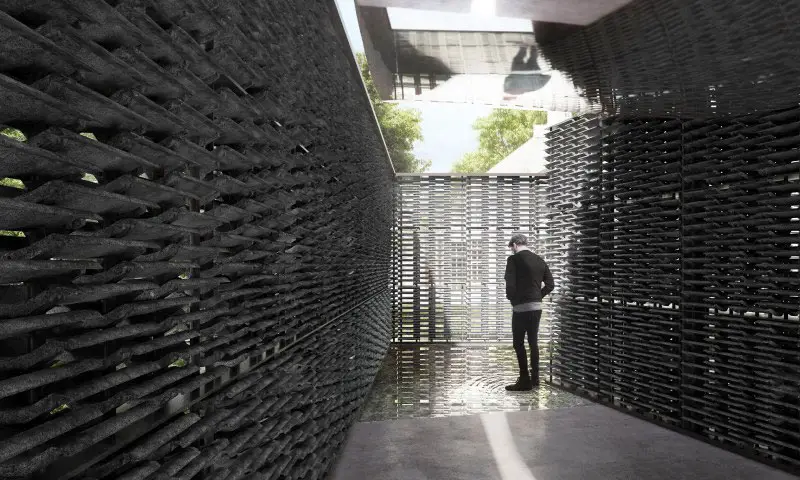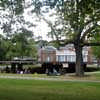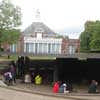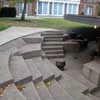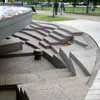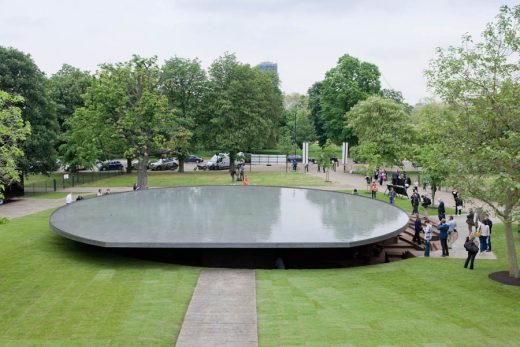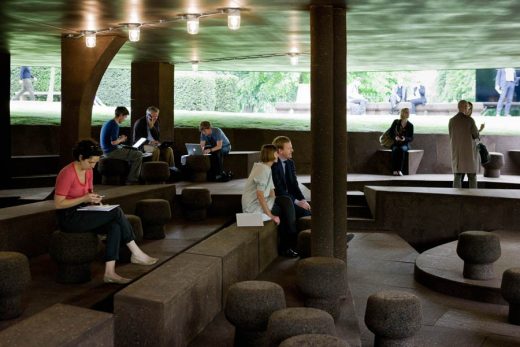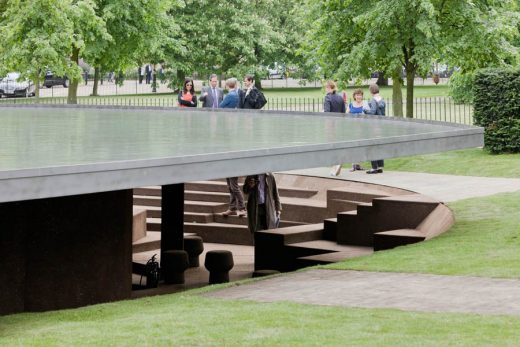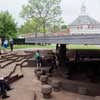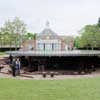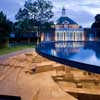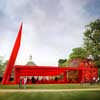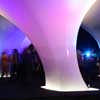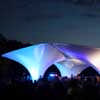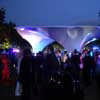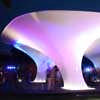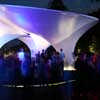Serpentine Gallery Pavilion 2018, Frida Escobedo Architect design project, England Arts building location pictures
Serpentine Pavilion London : Kensington Gardens Gallery
2018 Arts Project in Kensington Gardens, London, UK design by Mexican Architect Frida Escobedo
2018 Serpentine Pavilion Drone Footage
Bird’s Eye View
9 + 6 Jul 2018
Serpentine Pavilion 2018 Building
AECOM has released drone footage of the 2018 Serpentine Pavilion, which opened to the public last week, so that people can experience the project from a bird’s eye view. For the sixth year running, AECOM, in collaboration with David Glover, delivered engineering and technical design services for the project.
Ross Manship, Lead Drone Pilot, AECOM, said: “The beauty of a project like the Serpentine Pavilion is that it can look so different from various angles and usually people are only given this perspective from the ground. It’s great to give people an aerial view of this iconic and inspirational project.
“Working on this project makes a change from my usual day job, which usually involves working with drones on infrastructure projects or 3D visualisations of proposed developments, collecting photos and videos to be used in public consultations. We have the capability in house to add 3D visualisations of proposed developments and the eye in the sky view from a drone really helps to create a view of how things might look that people can really grasp.
“AECOM has a centre of excellence in Nottingham which builds on previous Research Partnerships with the University of Nottingham focusing on drone use. AECOM has been a major player in the use of drones worldwide for a number of years and part of the role of the centre of excellence is to engage with AECOM’s worldwide drone community and ensure best practice is adopted and adhered to within UK based operations. AECOM is a big believer in leveraging global expertise to deliver excellence locally.”
The Mexican architect Frida Escobedo, celebrated for dynamic projects that reactivate urban space, was commissioned to design this year’s Serpentine Pavilion. AECOM has worked closely with the architect, the Serpentine Galleries and contractor, Stage One Creative Services, to develop the concept into a finely detailed construction for the public to enjoy.
The Serpentine Pavilion is one of the top ten most-visited architectural and design exhibitions in the world. Each year, the Serpentine Galleries commissions an international architect to design a temporary Pavilion for the Gallery grounds.
Last year, AECOM provided engineering and technical advisory services for Diébédo Francis Kéré’s Pavilion, which was a bold, innovative structure that brought the architect’s characteristic sense of light and life to the lawns of Kensington Gardens. In 2016, for the first time, the Serpentine Galleries expanded its annual architecture programme to include four Summer Houses and in 2015, AECOM helped to bring selgascano’s colourful, translucent, chrysalis-like design to life. In 2014 the company helped design and deliver Smiljan Radić’s toroidal shell structure and in 2013 it provided engineering and technical design services for Sou Fujimoto’s cloud-like Pavilion.
11 Jun 2018
2018 Serpentine Pavilion by Frida Escobedo with AECOM
Q&A with the AECOM Serpentine team, Jon Leach, Amy Koerbel and Michael Orr.
June 11th – British architect Adrian Welch, Founding Editor of e-architect, interviews AECOM’s Project Engineers for Mexican architect Frida Escobedo’s Serpentine Pavilion about their role in this internationally renowned cultural project.
– I’m guessing you haven’t worked with Frida Escobedo before? I believe this is her first building in Europe, did you research her work before you met her? Can you tell us a little about meeting her?
None of us have had the pleasure of working with Frida before she was appointed to design the 2018 Pavilion. As always with Pavilion architects we do as much research on their previous projects as we can to get a sense of their architectural style.
Frida has actually worked in Europe before, and not too far from the Serpentine Gallery – she created an Aztec-inspired installation in the V&A courtyard back in 2015. Our first meeting with Frida was in December 2017, shortly after being appointed, and it was clear that she had a very strong idea as to what her Pavilion was going to be about but also that she was ready and willing to come along the journey of design that the Serpentine Pavilion demands.
Serpentine Gallery Pavilion 2018 by architect Frida Escobedo:
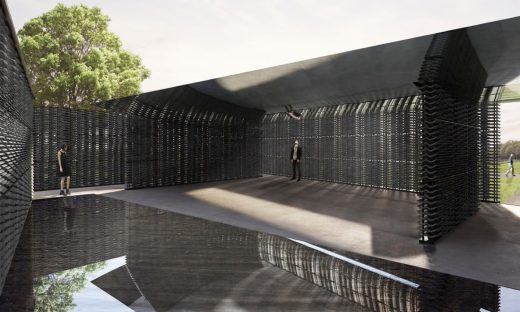
image © Frida Escobedo, Taller de Arquitectura, Rendering by Atmósfera
– did you come up with any technical challenges in forming the celosia (traditional breeze wall) formed from cement roof tiles?
The main technical challenge in forming the celosia was physically sourcing the bespoke cement roof tiles used to create the effect. To allow the tiles to slot over the steel framework which provides the structure to the walls, holes had to be formed in each corner of the tile. The exact size and position of these holes was determined on a trial and error basis by the tile supplier and it was quickly determined that the only way to get the tiles made in the quantities required was to fire them with the holes pre-formed, as opposed to drilling standard stock tiles.
The traditional design stage of the Pavilion is in January/February, allowing maximum time for off-site fabrication ahead of construction starting in April. What we discovered when we went to market was that January/February is when tile manufacturers are busy producing their stock of tiles for the busy summer house building season. This meant in order to secure the bespoke tiles, we had to have them ordered by the 2nd January 2018.
The pre-determined hole positions in the tiles meant that the geometry of the supporting structure was also defined. The AECOM team moved quickly from analysing scratch digital models to undertaking tests on full-scale mock ups in coordination with the contractor, Stage One. The tests allowed the dynamic response of the heavy cantilevering wall to be accurately determined and details agreed for fabrication.
Architect Frida Escobedo:
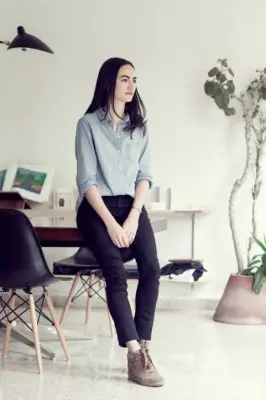
photo © Cuauhtemoc García
– this is a prestigious commission for AECOM, with the company remaining involved for six years delivering a range of technical advisory services, can you tell me how you tackle the project generally, in terms of resource and programme?
The Serpentine Pavilion is a prestigious commission, which AECOM are delighted to be associated with. One of the joys of the Pavilion project is seeing how differently a similar brief can be re-imagined year on year by the chosen architect and then working together with them, the Client and the contractor to ensure it gets designed and built within the same six month window.
The relationship between all parties is important, and the whole team works hard to understand the architect’s vision and then apply our combined experience to deliver that vision. The programme for the project is very fast moving and requires design-led, quick and pragmatic decision making.
AECOM responds to this by generally keeping the same key team members on the project year-on-year, so that we bring that depth of project-specific experience to each Pavilion. Additional specialist resource is then brought in and out depending on the demands of the individual Pavilion, and becomes a labour of love for all involved.
– the images show what appears to be a seamless curved mirrored soffit, how are the inevitable panels connected to each other and to the light breeze wall structure below?
The curved, mirrored, stainless soffit to the roof was a late addition to the design, brought in to increase the number of different interactions of light and shadow around the Pavilion. The ‘seamless’ panels are actually broken down into smaller trapezoidal shaped panels, sized to suit standard sheet sizes to reduce wastage.
The panels are fixed to purlins which span between the primary structure with countersunk square head screws. The inevitable gaps between the panels have been expressed to allow for construction tolerances in the build, with strips of stainless steel used to splice the plates together, set back to create a small shadow gap.
Serpentine Gallery Pavilion in 2018 by architect Frida Escobedo:
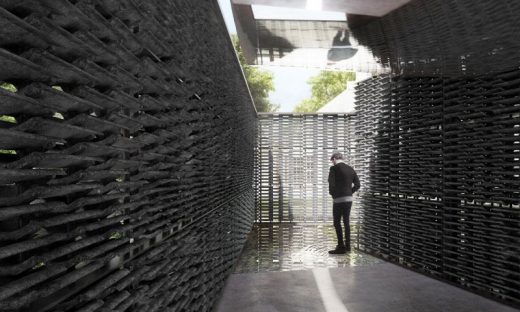
photograph : Rafael Gamo
– What were the major obstacles created by the tight construction timescale of around six weeks, for example the inclusion of a pool and associated drainage, pump, etc.?
Buildability, and the ability to easily de-mount and re-build the Pavilion is a major driver in the design. The architectural intent produced by Frida provided an unique opportunity to modularise the build, especially the celosia. Each wall module was designed to be fully fabricated, including tiles in approximately 1m x 1m squares on elevation off site. The pre-assembled modules could then be stacked up on site like giant Lego bricks and welded together to provide structural continuity.
The inclusion of the pool was an interesting design challenge and the first AECOM-designed Pavilion to include a mechanical water feature. The exact detail of the pool took a little while to agree but ultimately simplicity won out – cement screed poured between standard ACO drains provide the level surface for the pool with input and drainage pipes connected to the drains. The installation of the pool itself was decoupled from the critical path as it could be constructed in and around the build of the walls and the roof.
Frida Escobedo, La Tallera, 2012, Cuernavaca, Morelos, Mexico:
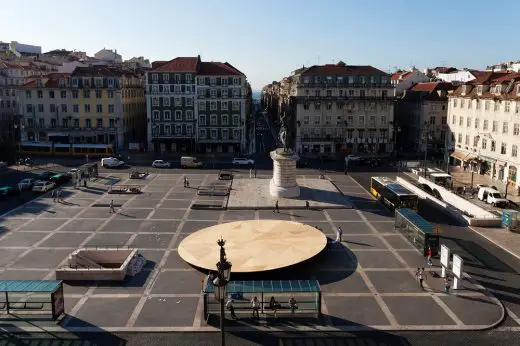
photo : Rafael Gamo
– The pavilion hosts a range of events including a café and free family activities during the day and a space for the Park Nights programme of performative works by artists, writers and musicians by night, how did AECOM facilitate this changing programme? What were the key challenges?
Part of AECOM’s technical advisory role is to guide the architect through the various usage requirements of the Pavilion. During the day it is free and open to all members of the public and at night is generally closed off for private events or performances. The changing nature of the Pavilion comes with its own set of challenges.
As a fully licenced venue, it must achieve certain requirements related to fire escapes, lighting levels and material performance in the case of fire. It must also be fully accessible to non-able bodied members of the public which sets minimum corridor widths and gradients on the floor finish. The Pavilion is also designed with an eye on how members of the public might choose to interact with it and is therefore designed in ways to discourage the more agile members from climbing the structure, whilst ensuring if they do that it remains safe and stable
– Finally, how does this year’s design challenge compare to working on Diébédo Francis Kéré’s pavilion?
The design challenge for Frida’s Pavilion revolved mainly around the procurement of the tiles that form the celosia. The final tile pattern was determined by what could be sourced in the time we had available. From the tile pattern, the overall dimensions of the Pavilion were set, along with the span of the roof. Therefore the Pavilion design this year was very much based around a series of simple but carefully considered building blocks, compared with last year’s which evolved more organically and involved more experimentation with digital prototypes and geometry rationalisation.
In both cases the design of the roof, whilst a relatively short span, borrowed inherent knowledge within the AECOM team of designing long-span roofs for sports and aviation projects, ensuring that the critical details, such as achieving a flat, crisp edge to the east and west sides could be easily constructed.
Interview by architect Adrian Welch, e-architect Founder & Co-Editor
7 Jun + 15 Feb 2018
Serpentine Pavilion 2018 Construction
Construction starts on 2018 Serpentine Pavilion by Frida Escobedo with AECOM
Construction of the 2018 Serpentine Pavilion in Kensington Gardens, London, has started. For the sixth year running, AECOM, in collaboration with David Glover, are delivering engineering and technical design services for the project.
The Mexican architect Frida Escobedo, celebrated for dynamic projects that reactivate urban space, was commissioned to design this year’s Serpentine Pavilion. AECOM has worked closely with the architect, the Serpentine Galleries and contractor, Stage One Creative Services, to develop the concept into a finely detailed construction, ready for the public to enjoy upon its opening in June.
Frida Escobedo, La Tallera, 2012, Cuernavaca, Morelos, Mexico:
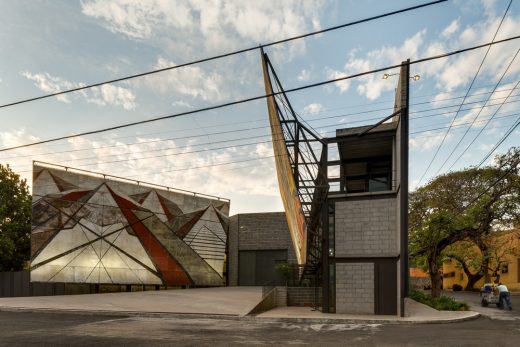
photo : Rafael Gamo
Escobedo’s Pavilion will take the form of an enclosed courtyard, comprised of two rectangular volumes positioned at an angle. While the outer walls will be aligned with the Serpentine Gallery’s eastern façade, the axis of the internal courtyard will align directly to the north. Internal courtyards are a common feature of Mexican domestic architecture, while the Pavilion’s pivoted axis refers to the Prime Meridian, which was established in 1851 at Greenwich and became the global standard marker of time and geographical distance.
Frida Escobedo, Civic Stage, 2013, Close-Closer- Lisbon Architecture Triennale, Lisbon, Portugal:
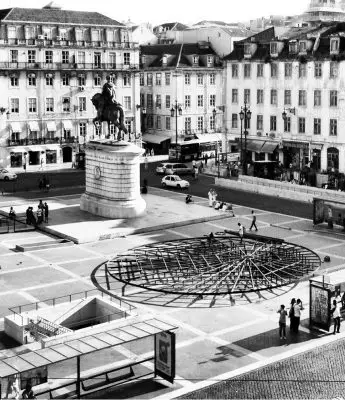
photography : Frida Escobedo, Catarina Botelho
The curved underside of the canopy will be clad with mirrored panels, and a triangular pool cast into the Pavilion floor will trace its boundary directly beneath the edge of the roof, along the north axis of the Meridian. As the sun moves across the sky, reflected and refracted by these features, visitors may feel a heightened awareness of time spent in play, improvisation and contemplation over the summer months.
Jon Leach, Director, AECOM, said: “The Serpentine Pavilion is always an inspirational project to wor on, and this year’s is no different. Our engineering and technical team plays an important role in the creative process, working closely with the architect to transform their design into a functional and buildable space without losing sight of their original vision.”
Amy Koerbel, Regional Director, AECOM, added: “For us as engineers, the key to delivering a successful pavilion is a highly collaborative approach to transform the architect’s vision into reality. The challenge of designing and constructing the Serpentine Pavilion within the tight programme constraints always results in a spontaneity in the process, which requires mutual trust and very close working relationship from all parties.”
La Tallera, 2012, Cuernavaca, Morelos, Mexico, by architect Frida Escobedo:
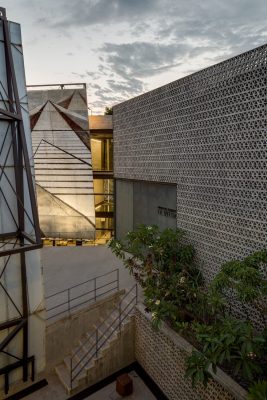
photo : Rafael Gamo
15 Feb 2018
Frida Escobedo to Design Serpentine Pavilion 2018
Frida Escobedo Wins 2018 Serpentine Pavilion Commission
The Serpentine Gallery has announced its selection for the 18th annual Serpentine Pavilion: Mexican architect Frida Escobedo will design a temporary structure for the gallery’s lawn in London’s Kensington Gardens. Born in 1979, Escobedo is the youngest architect yet to accept the commission.
Escobedo founded her architecture practice in Mexico City in 2006.
Architect Frida Escobedo, celebrated for dynamic projects that reactivate urban space, has been commissioned to design the Serpentine Pavilion 2018. Harnessing a subtle interplay of light, water and geometry, her atmospheric courtyard-based design draws on both the domestic architecture of Mexico and British materials and history, specifically the Prime Meridian line at London’s Royal Observatory in Greenwich.
Escobedo (b. 1979, Mexico City) is the 18th and youngest architect yet to accept the invitation to design a temporary Pavilion on the Serpentine Gallery lawn in Kensington Gardens. This pioneering commission, which began in 2000 with Zaha Hadid, has presented the first UK buildings of some of the biggest names in international architecture. In recent years, it has grown into a hotly anticipated showcase for emerging talent, from Sou Fujimoto of Japan to selgascano of Spain and Bjarke Ingels of Denmark. Serpentine Galleries Artistic Director Hans Ulrich Obrist and CEO Yana Peel selected this year’s architect, with advisors David Adjaye and Richard Rogers.
El Eco Pavilion in Mexico City design by architect Frida Escobedo:
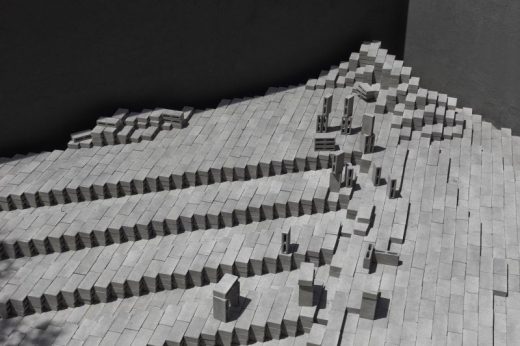
photo : Rafael Gamo
British-made materials will be used in the Pavilion’s construction, chosen for their dark colours and textured surfaces. A celosia – a traditional breeze wall also common to Mexican architecture – will be here composed of a lattice of cement roof tiles that diffuse the view out into the park, transforming it into a vibrant blur of greens and blues from within. Two reflecting elements will emphasise the movement of light and shadow inside the Pavilion over the course of the day.
Escobedo’s prize-winning work in urban reactivation ranges from housing and community centres to hotels and galleries. In 2006, she founded her practice in Mexico City, with significant national projects including the Librería del Fondo Octavio Paz and an extension of La Tallera Siqueiros gallery in Cuernavaca. Her designs have featured at the Venice Architecture Biennale (2012 and 2014), the Lisbon Architecture Triennale (2013), and in San Francisco, London and New York. Recent projects include Stanford University’s Graduate School of Business and social housing projects in Guerrero and Saltillo, Mexico. She lectures nationally and internationally, and has won multiple awards and accolades.
The Serpentine Pavilion 2018 will once again be a platform for Park Nights, the Serpentine’s annual programme of experimental and interdisciplinary evenings on selected Fridays. Practitioners in the fields of art, architecture, music, film, theory and dance will be commissioned to create new, site-specific works in response to Escobedo’s design, offering unique ways of experiencing architecture and performance, sponsored by COS.
Building on its 2017 success, Radical Kitchen also returns to the Pavilion on selected Thursday lunchtimes, inviting community groups, artists, activists, writers and architects to form connections through food. This programme of workshops, performances and talks will address geological time, empire and movements, inspired by the ideas behind Escobedo’s Pavilion design. The Architecture Family Pack and Programme, sponsored by COS, will give children and their families the chance to explore the Serpentine Pavilion from playful and original perspectives.
The Serpentine Pavilion 2018 will be open every day from 10am to 6pm, excluding 18/19 June when it will close, re-opening at 1pm on 20 June.
Serpentine Pavilion Architect’s Statement:
The design for the Serpentine Pavilion 2018 is a meeting of material and historical inspirations inseparable from the city of London itself and an idea which has been central to our practice from the beginning: the expression of time in architecture through inventive use of everyday materials and simple forms. For the Serpentine Pavilion, we have added the materials of light and shadow, reflection and refraction, turning the building into a timepiece that charts the passage of the day.
Website: Frida Escobedo to Design Serpentine Pavilion 2018
Serpentine Pavilion 2021 designed by Counterspace
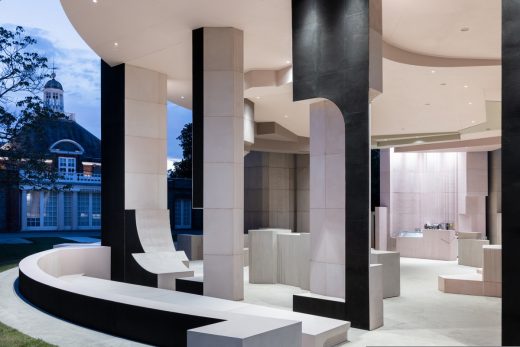
photograph © Counterspace Photo: Iwan Baan
Serpentine Pavilion 2021
22 + 21 Sep 2017
Serpentine Pavilion 2017
Serpentine Pavilion design by Francis Kéré
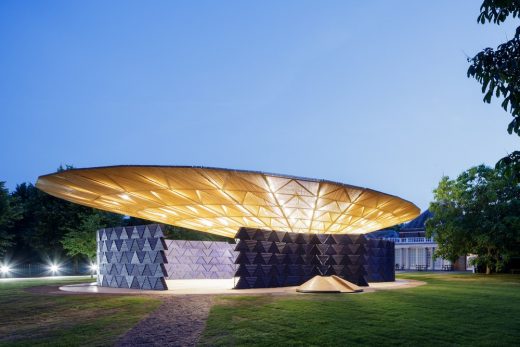
photograph by Iwan Baan, Courtesy AECOM
Serpentine Pavilion 2017 by architect Francis Kéré
Due to popular demand the pavilion will remain open for an additional six weeks, until 19th November. For the fifth year running, AECOM, in collaboration with David Glover, delivered technical advisory services for the Pavilion, including structural and civil engineering, fire engineering, electrical engineering and lighting design. Diébédo Francis Kéré, an architect from Burkina Faso responded to the brief with a bold, innovative structure that brings his characteristic sense of light and life to the lawns of Kensington Gardens.
page updated 8 Sep 2016 ; 22 Aug 2013
Serpentine Pavilion 2013
Serpentine Pavilion design by Sou Fujimoto
Sou Fujimoto is a 41-year-old Japanese architect.
The Serpentine Gallery Pavilion 2013 will be designed by multi award-winning Japanese architect Sou Fujimoto.
“It is a really fundamental question how architecture is different from nature, or how architecture could be part of nature, or how they could be merged…what are the boundaries between nature and artificial things.” Sou Fujimoto
Serpentine Pavilion 2013 video – external link
He is the thirteenth and, at 41, youngest architect to accept the invitation to design a temporary structure for the Serpentine Gallery. The most ambitious architectural programme of its kind worldwide, the Serpentine’s annual Pavilion commission is one of the most anticipated announcements on the cultural calendar. Past Pavilions have included designs by Herzog & de Meuron and Ai Weiwei (2012), Frank Gehry (2008), the late Oscar Niemeyer (2003) and Zaha Hadid, who designed the inaugural structure in 2000.
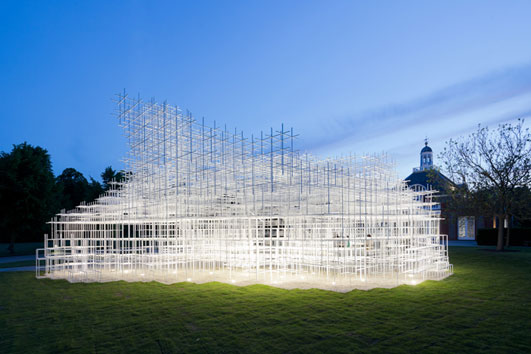
Serpentine Gallery Pavilion 2013 designed by Sou Fujimoto © Sou Fujimoto Architects ; Image © 2013 Iwan Baan
Widely acknowledged as one of the most important architects coming to prominence worldwide, Sou Fujimoto is the leading light of an exciting generation of artists who are re-inventing our relationship with the built environment. Inspired by organic structures, such as the forest, the nest and the cave, Fujimoto’s signature buildings inhabit a space between nature and artificiality. Fujimoto has completed the majority of his buildings in Japan, with commissions ranging from the domestic, such as Final Wooden House, T House and House N, to the institutional, such as the Musashino Art Museum and Library at Musashino Art University.
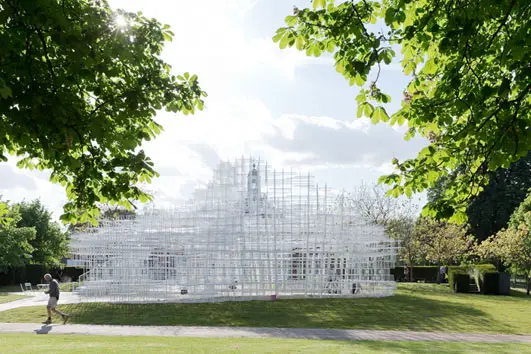
Serpentine Gallery Pavilion 2013, designed by Japanese architect Sou Fujimoto © Sou Fujimoto Architects ; Image © 2013 Iwan Baan
Occupying some 350 square-metres of lawn in front of the Serpentine Gallery, Sou Fujimoto’s delicate, latticed structure of 20mm steel poles will have a lightweight and semi-transparent appearance that will allow it to blend, cloud-like, into the landscape and against the classical backdrop of the Gallery’s colonnaded East wing. Designed as a flexible, multi-purpose social space – with a café sited inside – visitors will be encouraged to enter and interact with the Pavilion in different ways throughout its four-month tenure in London’s Kensington Gardens.
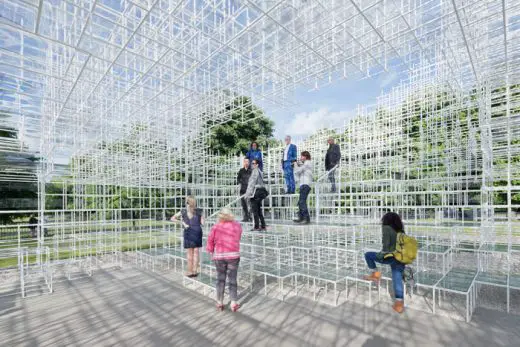
Serpentine Gallery Pavilion 2013 design by Sou Fujimoto © Sou Fujimoto Architects ; Image © 2013 Iwan Baan
Julia Peyton-Jones, Director, and Hans Ulrich Obrist, Co-Director, Serpentine Gallery, said:
“We are thrilled to be working with one of the most fascinating architects in the world today. A visionary, who has conceived an extraordinary response to our invitation to design the Serpentine Gallery Pavilion, Sou Fujimoto has designed a structure that will enthral everyone that encounters it throughout the summer.”
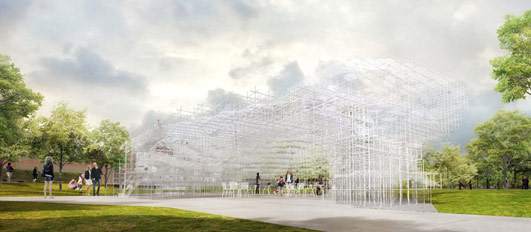
Serpentine Gallery Pavilion 2013 designed by architect Sou Fujimoto – indicative CGI © Sou Fujimoto Architects
Describing his design concept, Sou Fujimoto said:
“For the 2013 Pavilion I propose an architectural landscape: a transparent terrain that encourages people to interact with and explore the site in diverse ways. Within the pastoral context of Kensington Gardens, I envisage the vivid greenery of the surrounding plant life woven together with a constructed geometry. A new form of environment will be created, where the natural and the man-made merge; not solely architectural nor solely natural, but a unique meeting of the two.
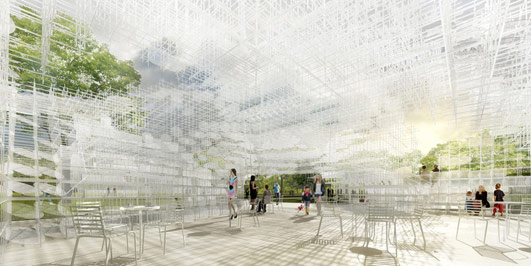
Serpentine Gallery Pavilion 2013 by Sou Fujimoto – CGI © Sou Fujimoto Architects
The Pavilion will be a delicate, three-dimensional structure, each unit of which will be composed of fine steel bars. It will form a semi-transparent, irregular ring, simultaneously protecting visitors from the elements while allowing them to remain part of the landscape. The overall footprint will be 350 square-metres and the Pavilion will have two entrances. A series of stepped terraces will provide seating areas that will allow the Pavilion to be used as a flexible, multi-purpose social space.
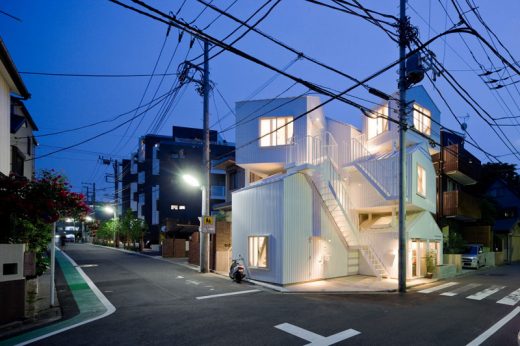
‘Tokyo Apartment’ Designed by Sou Fujimoto Architects © Iwan Baan
The delicate quality of the structure, enhanced by its semi-transparency, will create a geometric, cloud-like form, as if it were mist rising from the undulations of the park. From certain vantage points, the Pavilion will appear to merge with the classical structure of the Serpentine Gallery, with visitors suspended in space.”
Fujimoto is the third Japanese architect to accept the invitation to design the Serpentine Gallery Pavilion, following Toyo Ito in 2002 and Kazuyo Sejima & Ryue Nishizawa of SANAA in 2009
Serpentine Sackler Gallery, Kensington Gardens, London, UK
Design: Zaha Hadid Architects
Serpentine Pavilion 2012
Serpentine Pavilion design by Herzog + de Meuron with Ai Weiwei
Photos by Adrian Welch, 1 Oct 2012:
5 Jun 2012
Serpentine Gallery Pavilion 2012
Serpentine Gallery Pavilion 2012 design by Herzog and de Meuron with Ai Weiwei
The Serpentine Gallery reveals photos of the completed Pavilion design by Herzog & de Meuron and Ai Weiwei
This year’s Pavilion takes visitors beneath the Serpentine’s lawn to explore the hidden history of its previous Pavilions. Eleven columns characterising each past Pavilion and a twelfth column representing the current structure support a floating platform roof 1.4 metres above ground.
The Pavilion’s interior is clad in cork, a sustainable building material chosen for its unique qualities and to echo the excavated earth. Taking an archaeological approach, the architects have created a design that will inspire visitors to look beneath the surface of the park as well as back in time across the ghosts of the earlier structures.
8 May 2012
Serpentine Gallery Pavilion 2012 Design
Serpentine Gallery Pavilion – Herzog and de Meuron with Ai Weiwei
Serpentine Gallery reveals plans for Pavilion designed by Herzog & de Meuron and Ai Weiwei
The Serpentine Gallery today released plans for the 2012 Serpentine Gallery Pavilion designed by Herzog & de Meuron and Ai Weiwei. It will be the twelfth commission in the Gallery’s annual series, the world’s first and most ambitious architectural programme of its kind.
The design team responsible for the celebrated Beijing National Stadium, which was built for the 2008 Olympic Games, comes together again in London in 2012 for the Serpentine’s acclaimed annual commission, being presented as part of the London 2012 Festival, the culmination of the Cultural Olympiad. The Pavilion is Herzog & de Meuron and Ai Weiwei’s first collaborative built structure in the UK.
Serpentine Gallery Pavilion 2012
Designed by Herzog & de Meuron & Ai Weiwei
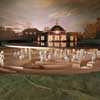
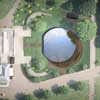
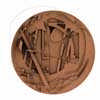
images : © 2012, by Herzog & de Meuron and Ai Weiwei
Julia Peyton-Jones, Director, and Hans Ulrich Obrist, Co-Director, Serpentine Gallery, said: “It is a great honour to be working with Herzog & de Meuron and Ai Weiwei, the design team behind Beijing’s superb Bird’s Nest Stadium. In this exciting year for London we are proud to be creating a connection between the Beijing 2008 and the London 2012 Games. We are enormously grateful for the help of everyone involved, especially Usha and Lakshmi N. Mittal, whose incredible support has made this project possible.”
The Serpentine Gallery Pavilion will operate as a public space and as a venue for Park Nights, the Gallery’s high-profile programme of public talks and events. Connecting to the archaeological focus of the Pavilion design, Park Nights will culminate in October with the Serpentine Gallery Memory Marathon, the latest edition of the annual Serpentine Marathon series conceived by Hans Ulrich Obrist, now in its seventh year. The Marathon series began in 2006 with the 24-hour Serpentine Gallery Interview Marathon; followed by the Experiment Marathon in 2007; the Manifesto Marathon in 2008; the Poetry Marathon in 2009, the Map Marathon in 2010 and the Garden Marathon in 2011.
The 2012 Pavilion has been purchased by Usha and Lakshmi N. Mittal and will enter their private collection after it closes to the public in October 2012.
Serpentine Gallery Pavilion 2012
Designed by Herzog & de Meuron & Ai Weiwei
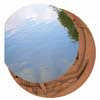
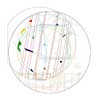
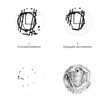
images : © 2012, by Herzog & de Meuron and Ai Weiwei
Opening
The Serpentine Gallery Pavilion 2012 designed by Herzog & de Meuron and Ai Weiwei will take place from 1 June to 14 October 2012.
Herzog & de Meuron and Ai Weiwei said:
“Every year since 2000, a different architect has been responsible for creating the Serpentine Gallery’s summer Pavilion for Kensington Gardens. That makes eleven Pavilions so far, our contribution will be the twelfth. So many Pavilions in so many different shapes and out of so many different materials have been conceived and built that we tried instinctively to sidestep the unavoidable problem of creating an object, a concrete shape.
Jacques Herzog (left) and Pierre de Meuron (right)
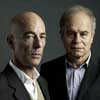
image © 2012, by Herzog & de Meuron and Ai Weiwei
“Our path to an alternative solution involves digging down some five feet into the soil of the park until we reach the groundwater. There we dig a waterhole, a kind of well, to collect all of the London rain that falls in the area of the Pavilion. In that way we incorporate an otherwise invisible aspect of reality in the park – the water under the ground – into our Pavilion.
As we dig down into the earth we encounter a diversity of constructed realities such as telephone cables and former foundations. Like a team of archaeologists, we identify these physical fragments as remains of the eleven Pavilions built between 2000 and 2011. Their shape varies: circular, long and narrow, dots and also large, constructed hollows that have been filled in. These remains testify to the existence of the former Pavilions and their greater or lesser intervention in the natural environment of the park.
“All of these foundations will now be uncovered and reconstructed. The old foundations form a jumble of convoluted lines, like a sewing pattern. A distinctive landscape emerges out of the reconstructed foundations which is unlike anything we could have invented; its form and shape is actually a serendipitous gift. The three-dimensional reality of this landscape is astonishing and it is also the perfect place to sit, stand, lie down or just look and be amazed. In other words, the ideal environment for continuing to do what visitors have been doing in the Serpentine Gallery Pavilions over the past eleven years – and a discovery for the many new visitors anticipated for the London 2012 Olympic Games.

Film Still Bird’s Nest – Herzog & de Meuron in China © 2008 by T&C Film AG
“On the foundations of each single Pavilion, we extrude a new structure (supports, walls) as load-bearing elements for the roof of our Pavilion – eleven supports all told, plus our own column that we can place at will, like a wild card. The roof resembles that of an archaeological site. It floats a few feet above the grass of the park, so that everyone visiting can see the water on it, its surface reflecting the infinitely varied, atmospheric skies of London. For special events, the water can be drained off the roof as from a bathtub, from whence it flows back into the waterhole, the deepest point in the Pavilion landscape. The dry roof can then be used as a dance floor or simply as a platform suspended above the park.”
Cork
Referring to the extensive use of cork in the design, Herzog & de Meuron said: “Cork is a natural material with wonderful haptic and olfactory qualities with the versatility to be carved, cut, shaped and formed, as demonstrated in many historical examples of cork architectural models.”
National Stadium, Beijing, China
Herzog & de Meuron and Ai Weiwei
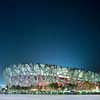
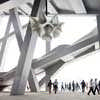
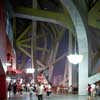
images © Iwan Baan
Serpentine Gallery Pavilion 2012 images / information from Serpentine Gallery
7 Feb 2012
Serpentine Gallery Pavilion in 2012
Serpentine Gallery Pavilion – Herzog and de Meuron with Ai Weiwei
Herzog and de Meuron teams up with Ai Weiwei on Serpentine pavilion
Four years after designing the spectacular Bird’s Nest Olympic stadium in Beijing, the Swiss architects Herzog & de Meuron and the Chinese artist Ai Weiwei are to reunite for a London 2012 project.
The Serpentine Gallery announced today that the Beijing team would collaborate once more to design this year’s pavilion – the 12th commission in what has become a major annual event on the architecture calendar.
Julia Peyton-Jones, the director of the Serpentine Gallery, said it was “tremendously exciting”. She added: “What is so fantastic is that it is this extraordinary link of the two games, a Beijing-London axis…These are old and dear friends, so for them (Jacques Herzog, Pierre de Meuron and Ai Weiwei) they are picking up where they left off – it is a continuation of a conversation that began in Beijing to great effect and they have conceived something really remarkable for our lawn.”
Ai Weiwei has been planning the project with Herzog and de Meuron using Skype and it remains to be seen whether he will be allowed to leave China by the time the pavilion is up in June.
A few details of their plans have been revealed including the indication of it being the lowest pavilion ever, with the roof barely 5ft off the ground. People will be able to go under it because they also plan to dig down a few feet.
In a joint statement they said they would celebrate past Serpentine Pavilions as well as their own but it would not look like anything that had gone before. “So many pavilions in so many different shapes and out of so many different materials have been conceived and built that we tried instinctively to sidestep the unavoidable problem of creating an object, a concrete shape.”
There will be 12 columns – 11 representing the past pavilions and one for the present – supporting a floating platform roof 5ft from the ground. That roof will collect rain water and reflect the sky as well as being capable of being drained and used for special events “as a dance floor or simply as a platform suspended above the park”.
The pavilion, they promise, will become “the perfect place to sit, stand, lie down or just look and be amazed”.
It will go up in June as part of the London 2012 festival which will mark the culmination of the Cultural Olympiad.
Serpentine Gallery Event
Serpentine Gallery Garden Marathon
Two-day live event hosts artists, scientists and thinkers creating garden inspired works
15-16 Oct 2011
The Serpentine Gallery Garden Marathon is the sixth in the Gallery’s acclaimed Marathon series. This two-day event is an exploration of the concept of the garden and inspired by the Serpentine Gallery Pavilion 2011 designed by Peter Zumthor and the garden inside, designed by Piet Oudolf.
Contributions will include explorations of the spatial, urban and scientific importance of gardens by key figures from horticulture, design and architecture. The Marathon will also present works by artists, poets, writers and philosophers, exploring the significance of the garden in our experience of the world, as well as cutting-edge research in biodiversity, conservation and genetics.
Elizabeth Diller – The Highline, New York:
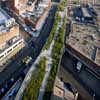
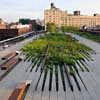
photos : Iwan Baan
Marathon participants:
Curated by Hans Ulrich Obrist, Co-Director of Exhibitions and Programmes and Director of International Projects; Sally Tallant, Head of Programmes; Nicola Lees, Public Programmes Curator and Lucia Pietroiusti, Assistant Curator, Serpentine Gallery. Gardens have been a source of inspiration for artists, writers and poets such as Ian Hamilton Finlay whose words can be seen in the permanent installation in the Gallery’s grounds.
Charles Jencks – The Avenue of Doubles focuses through a sewer pipe on a volcano 375 million years old:
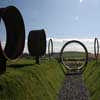
image from Serpentine Gallery
Serpentine Gallery Marathons are a unique series of events that bring together the fields of art, culture, science and technology. Previous Marathons have included last year’s Map Marathon 2010, following on from the Poetry Marathon 2009, Manifesto Marathon 2008, Experiment Marathon 2007 and the Interview Marathon 2006.
Stefano Boeri – Vertical Forest:
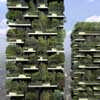
image from Serpentine Gallery
Serpentine Gallery Pavilion – Past Designs
Serpentine 2011 Pavilion by Peter Zumthor
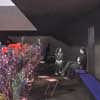
picture from Serpentine Gallery
Serpentine Pavilion 2010 by Jean Nouvel
Serpentine Pavilion 2009 by SANAA Architects
Serpentine Gallery – temporary shelters
2007
Zaha Hadid Architects
Location: Kensington Gardens, west London
Serpentine Pavilion 2007 design by Zaha Hadid Architects
Lilas Pavilion at Chatsworth House – 8 Sep 2016
Relocation of the ZHA design to Chatsworth.
Serpentine Gallery Pavilion info from Zaha Hadid Architects
Location: Kensington Gardens, London, W2 3XA, England, UK
London Building Designs
Contemporary London Architectural Designs
London Architecture Links – chronological list
London Architecture Tours – bespoke UK capital city walks by e-architect
Serpentine Pavilion London Architecture
Serpentine Gallery Pavilion 2015
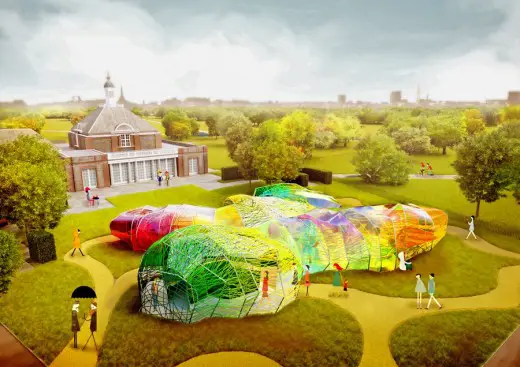
photo © Steven Kevin Howson / SelgasCano
Four Summer Houses in the Serpentine 2016 Programme
Serpentine Pavilion 2007 original architect : Snøhetta
Serpentine Pavilion architect 2006 : Rem Koolhaas
Serpentine Pavilion architect 2005 : Álvaro Siza & Eduardo Souto de Moura
Serpentine Pavilion architect 2003 : Oscar Niemeyer
Serpentine Pavilion architect 2002 : Toyo Ito
Serpentine Pavilion architect 2001 : Daniel Libeskind
Serpentine Pavilion architect 2000 : Zaha Hadid Architects
London Art Galleries
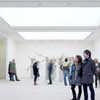
picture © Timothy Soar
Comments / photos for the Serpentine Pavilion page welcome

